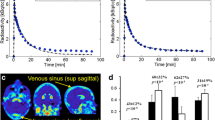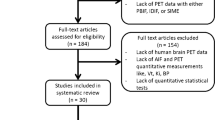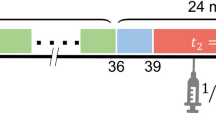Abstract
Purpose
To assess the robustness of a previously introduced method to obtain accurate image-derived input functions (IDIF) for three other tracers.
Methods
Dynamic PET and online blood data of five repeat [11C]PIB (Pittsburgh Compound-B) ([11C]PIB), six repeat (R)-[11C]verapamil, and ten single (R)-[11C]PK11195 studies were used. IDIFs were extracted from partial volume corrected scans using the four hottest pixels per plane method. Results obtained with IDIFs were compared with those using standard online measured arterial input functions (BSIF). IDIFs were used both with and without calibration based on manual blood samples.
Results
For (R)-[11C]verapamil, accurate IDIFs were obtained using noncalibrated IDIFs (slope 0.96±0.17; R 2 0.92±0.07). However, calibration was necessary to obtain IDIFs comparable to the BSIF for both [11C]PIB (slope 1.04±0.05; R 2 1.00±0.01) and (R)-[11C]PK11195 (slope 0.96±0.05; R 2 0.99±0.01). The need for calibration may be explained by the sticking property of both tracers, indicating that BSIF may be affected by sticking and therefore may be unreliable.
Conclusion
The present study shows that a previously proposed method to extract IDIFs is suitable for analysing [11C]PIB, (R)-[11C]verapamil and (R)-[11C]PK11195 studies, thereby obviating the need for online arterial sampling.





Similar content being viewed by others
References
Lammertsma AA, Hume SP. Simplified reference tissue model for PET receptor studies. Neuroimage 1996;4:153–8.
Lammertsma AA, Bench CJ, Hume SP, Osman S, Gunn K, Brooks DJ, et al. Comparison of methods for analysis of clinical [11C]raclopride studies. J Cereb Blood Flow Metab 1996;16:42–52.
Hall R. Vascular injuries resulting from arterial puncture of catheterization. Br J Surg 1971;58:513–6.
Machleder HI, Sweeney JP, Barker WF. Pulseless arm after brachial-artery catheterisation. Lancet 1972;1:407–9.
Chen K, Bandy D, Reiman E, Huang SC, Lawson M, Feng D, et al. Noninvasive quantification of the cerebral metabolic rate for glucose using positron emission tomography, 18F-fluoro-2-deoxyglucose, the Patlak method, and an image-derived input function. J Cereb Blood Flow Metab 1998;18:716–23.
Mourik JEM, Lubberink M, Klumpers UMH, Lammertsma AA, Boellaard R. Partial volume corrected image derived input functions for dynamic brain studies: methodology and validation for [11C]flumazenil. Neuroimage 2008;39:1041–50.
Mourik JE, van Velden FH, Lubberink M, Kloet RW, Berckel BN, Lammertsma AA, et al. Image derived input functions for dynamic high resolution research tomograph PET brain studies. Neuroimage 2008;43:676–86.
Price JC, Klunk WE, Lopresti BJ, Lu X, Hoge JA, Ziolko SK, et al. Kinetic modeling of amyloid binding in humans using PET imaging and Pittsburgh Compound-B. J Cereb Blood Flow Metab 2005;25:1528–47.
Vogelgesang S, Cascorbi I, Schroeder E, Pahnke J, Kroemer HK, Siegmund W, et al. Deposition of Alzheimer’s beta-amyloid is inversely correlated with P-glycoprotein expression in the brains of elderly non-demented humans. Pharmacogenetics 2002;12:535–41.
Toornvliet R, van Berckel BN, Luurtsema G, Lubberink M, Geldof AA, Bosch TM, et al. Effect of age on functional P-glycoprotein in the blood-brain barrier measured by use of (R)-[(11)C]verapamil and positron emission tomography. Clin Pharmacol Ther 2006;79:540–8.
Banati RB, Myers R, Kreutzberg GW. PK (‘peripheral benzodiazepine’)-binding sites in the CNS indicate early and discrete brain lesions: microautoradiographic detection of [3H]PK11195 binding to activated microglia. J Neurocytol 1997;26:77–82.
Boellaard R, van Lingen A, van Balen SC, Hoving BG, Lammertsma AA. Characteristics of a new fully programmable blood sampling device for monitoring blood radioactivity during PET. Eur J Nucl Med 2001;28:81–9.
Meyer E. Simultaneous correction for tracer arrival delay and dispersion in CBF measurements by the H215O autoradiographic method and dynamic PET. J Nucl Med 1989;30:1069–78.
Lubberink M, Greuter HNJM, Boellaard R, Luurtsema G, Lammertsma AA. Effect of plasma metabolite correction accuracy on kinetic analysis in positron emission tomography. Neuroimage. 2004;22:T119.
Gunn RN, Sargent PA, Bench CJ, Rabiner EA, Osman S, Pike VW, et al. Tracer kinetic modeling of the 5-HT1A receptor ligand [carbonyl-11C]WAY-100635 for PET. Neuroimage 1998;8:426–40.
Logan J. Graphical analysis of PET data applied to reversible and irreversible tracers. Nucl Med Biol 2000;27:661–70.
Schuitemaker A, van Berckel BN, Kropholler MA, Kloet RW, Jonker C, Scheltens P, et al. Evaluation of methods for generating parametric (R)-[11C]PK11195 binding images. J Cereb Blood Flow Metab 2007;27:1603–15.
Lubberink M, Luurtsema G, van Berckel BN, Boellaard R, Toornvliet R, Windhorst AD, et al. Evaluation of tracer kinetic models for quantification of P-glycoprotein function using (R)-[11C]verapamil and PET. J Cereb Blood Flow Metab 2007;27:424–33.
Boellaard R, Knaapen P, Rijbroek A, Luurtsema GJ, Lammertsma AA. Evaluation of basis function and linear least squares methods for generating parametric blood flow images using 15O-water and positron emission tomography. Mol Imaging Biol 2005;7:273–85.
Gunn RN, Lammertsma AA, Hume SP, Cunningham VJ. Parametric imaging of ligand-receptor binding in PET using a simplified reference region model. Neuroimage 1997;6:279–87.
Baudrexel S, Graf R, Knoess C, Vollmar S, Wienhard K. Derivation of the input function from dynamic PET images with the HRRT. Nuclear Science Symposium Conference Record 2004;6:3890–92.
Acknowledgements
This work was financially supported by the Netherlands Organisation for Scientific Research (NWO, VIDI Grant 016.066.309), the American Health Assistance Foundation (Grant A2005-026) and Internationale Stichting Alzheimer Research (Grant #05512). The authors would like to thank Floris H.P. van Velden for his useful comments and the PET radiochemistry and technology staff of the Division of Nuclear Medicine and PET Research for production of isotopes and acquisition of metabolites and PET data.
Author information
Authors and Affiliations
Corresponding author
Rights and permissions
About this article
Cite this article
Mourik, J.E.M., Lubberink, M., Schuitemaker, A. et al. Image-derived input functions for PET brain studies. Eur J Nucl Med Mol Imaging 36, 463–471 (2009). https://doi.org/10.1007/s00259-008-0986-8
Received:
Accepted:
Published:
Issue Date:
DOI: https://doi.org/10.1007/s00259-008-0986-8




